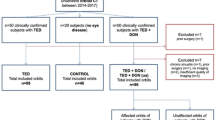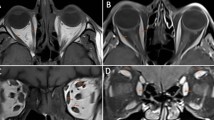Abstract
In cross section, extraocular muscles are more or less elliptical, with short and long diameters. We studied the ratio (R) of short to long diameter and investigated its use in quantitative assessment of the extraocular muscles in patients with Graves's disease. We measured the diameters on T1-weighted axial and coronal MRI and computed R for each extraocular muscle in 80 patients without and 40 with Graves's disease. We compared the measurements and R of the right and left orbits, and of men and women. The short diameter of all extraocular muscles apart from the superior oblique showed significant differences between men and women, and that of the inferior rectus varied significantly with age. R, however, was unrelated to sex or age. All patients with Graves's disease and an increased short diameter also had an increased R, but 6% of the muscles showed an increase in R, even though their short diameter was within the normal range.


Similar content being viewed by others
References
Valvassori GE (1995) Imaging of the head and neck. Thieme, New York, pp 158–215
Patrinely JR, Osborn AG, Anderson RL, Whiting AS (1989) Computed tomographic features of nonthyroid extraocular muscle enlargement. Ophthalmology 96: 1038–1047
Trokel SL, Hilal SK (1979) Recognition and differential diagnosis of enlarged extraocular muscles in computed tomography. Am J Ophthalmol 87: 503–512
Nagy EV, Toth J, Kaldi I, et al (2000) Graves' ophthalmopathy: eye muscle involvement in patients with diplopia. Eur J Endocrinol 14: 591–597
Weber AL, Dallow RL, Sabates NR (1996) Graves' disease of the orbit. Neuroimaging Clin North Am 6: 61–72
Nugent RA, Belkin RI, Neigel JM, et al (1990) Graves orbitopathy: 6. Correlation of CT and clinical findings. Radiology 177: 675–682
Yokoyama N, Nagataki S, Uetani M, Ashizawa K, Eguchi K (2002) Role of magnetic resonance imaging in the assessment of disease activity in thyroid-associated ophthalmopathy. Thyroid 12: 223–227
Ozgen A, Alp MN, Ariyurek M, Tutuncu NB, Can I, Gunalp I (1999) Quantitative CT of the orbit in Graves' disease. Br J Radiol 72: 757–762
Nishikawa M, Yoshimura M, Toyoda N, et al (1993) Correlation orbital muscle changes evaluated by magnetic resonance imaging and thyroid-stimulating antibody in patients with Graves ophthalmopathy. Acta Endocrinol 129: 213–219
Ozgen A, Ariyurek M (1998) Normative measurements of orbital structures using CT. Am J Roentgenol 170: 1093–1096
Lee JS, Lim DW, Lee SH, Qum BS, Kim HJ, Lee HJ (2001) Normative measurements of Korean orbital structures revealed by computerized tomography. Acta Ophthalmol Scand 79: 197–200
Ozgen A, Aydingoz U (2000) Normative measurements of orbital structures using MRI. J Comput Assist Tomogr 24: 493–496
Hatton MP, Rubin PA (2002) The pathophysiology of thyroid-associated ophthalmopathy. Ophthalmol Clin North Am 15: 113–119
Ohnishi T, Noguchi S, Murakami N, et al (1994) Extraocular muscles in Graves ophthalmopathy: usefulness of T2 relaxation time measurements. Radiology 190: 857–862
Utech CI, Khatibnia U, Winter PF, Wulle KG (1995) MR T2 relaxation time foe the assessment of retrobulbar inflammation in Graves' ophthalmopathy. Thyroid 5: 185–193
Forbes G, Gorman CA, Gerhing D, Baker HL (1983) Computer analysis of orbit fat and muscle volumes in Graves' ophthalmopathy. AJNR 4: 737–740
Forbes, G, Gorman CA, Brennan MD, Gehring DG, Ilstrup DM, Earnest F (1986) Ophthalmopathy of Graves' disease: computerized volume measurements of the orbital fat and muscle. AJNR 7: 651–656
Hallin ES, Feldon SE (1988) Graves' ophthalmopathy: I. Simple CT estimates of extraocular muscle volume. Br J Ophthalmol 72: 674–677
Firbank MJ, Coulthard A (2000) Evaluation of a technique for estimation of extraocular muscle volume using 2D MRI. Br J Radiol 73: 1282–1289
Author information
Authors and Affiliations
Corresponding author
Rights and permissions
About this article
Cite this article
Aydin, K., Güven, K., Sencer, S. et al. A new MRI method for the quantitative evaluation of extraocular muscle size in thyroid ophthalmopathy. Neuroradiology 45, 184–187 (2003). https://doi.org/10.1007/s00234-002-0930-8
Received:
Accepted:
Published:
Issue Date:
DOI: https://doi.org/10.1007/s00234-002-0930-8




